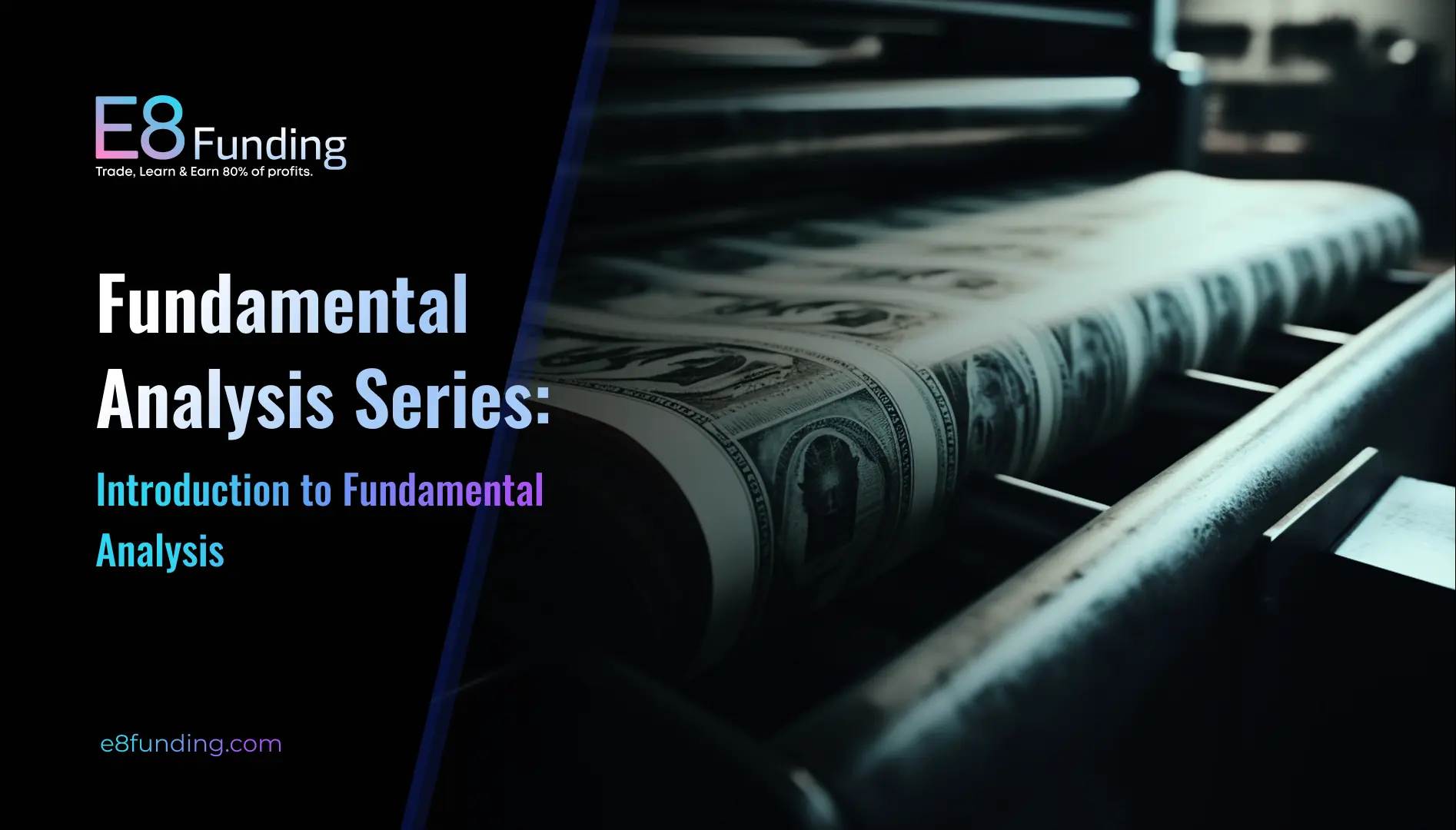5 Economic Indicators To Start With
In our previous FA series, we delved into the basics of Fundamental Analysis and, more recently, explored the use of the Economic Calendar—including where to find key events and data releases and how to effectively utilize this tool. In this chapter, we’re set to uncover the 5 most important economic indicators that not just fundamental traders watch and analyze.
What are Economic Indicators?
Economic indicators are statistics and data points that provide insights into the economic performance of a country, region, or sector. They are used to assess the health of the economy, understand economic trends, forecast future economic activity, and make informed decisions in policy-making, investment, and business strategy. Economic indicators can be broadly categorized into three main types: Leading, Lagging, and Coincident Indicators.
- Leading Indicators are like hints or clues about what’s likely going to happen in the economy in the future. These indicators help investors, businesses, and policymakers make decisions by giving them a sneak peek of economic trends. If companies are placing more orders for products or if people are feeling good about spending money, it suggests that the economy is likely to grow, similar to how your budget might change with the anticipation of a higher income.
- Lagging Indicators give us insights into the economy’s past health by showing changes that happened after economic trends or cycles began. For example, seeing how many people were unemployed or how prices changed a while back helps us understand the outcomes of previous economic decisions, much like looking back at your spending habits through an old bank statement to see how well you managed your budget.
- Coincident Indicators are like real-time updates on the economy’s health. They give us an immediate look at whether the economy is thriving or struggling by showing us things like how much people are spending, how many people have jobs, and the total value of everything being made and sold. It’s like getting a live feed of the economy’s performance at the very moment.
Central banks closely monitor these economic indicators to make crucial decisions about interest rates and monetary policy, aiming to maintain economic stability and foster growth. Government entities utilize this data to develop and implement fiscal policies that support the national economy’s health and growth. Investors and traders rely on these indicators to identify trends and make informed decisions about where to put their money. Business owners, on the other hand, use this information to strategize on expansion, production, and workforce needs, aligning their operations with the current economic climate. Lastly, economists analyze these indicators to predict future economic conditions and advise on policy-making. Together, these diverse groups use economic indicators as essential tools for navigating the complexities of the global economy, making informed decisions that aim to optimize growth, stability, and profitability.
Nonetheless, our article primarily targets traders, particularly those employing fundamental analysis in their trading endeavors or seeking to learn this analytical approach. With that in mind, let’s explore the essential economic indicators and their profound impact on the markets.
Key Economic Indicators
All market participants and especially Forex traders should closely watch key economic indicators because they provide vital clues about the strength and direction of a country’s economy, which directly impacts its currency value. By staying updated about these indicators, traders can anticipate potential currency movements and adjust their trading strategies accordingly. Factors such as interest rate decisions, GDP growth, employment figures, and inflation rates are particularly important as they can significantly influence market sentiment and exchange rates. Therefore, keeping track of these indicators is essential for successful forex trading. Another reason to stay updated on the release of such data is the considerable market volatility it often triggers. With a solid understanding of these indicators, traders can anticipate potential outcomes and effectively capitalize on the opportunities presented by these data releases. This proactive approach helps avoid uncertainty and allows traders to make informed decisions in response to market movements.
Gross Domestic Product
The Gross Domestic Product (GDP) Growth Rate serves as a fundamental measure of a country’s economic vitality. It quantifies the rate of change in the total value of goods and services produced within the country’s borders over a specific period, usually on a quarterly or annual basis.
The GDP growth rate is a critical economic indicator that offers insights into the health and direction of an economy. A positive growth rate indicates economic expansion, implying increased production, consumption, and investment. Conversely, a negative growth rate signals economic contraction or recession, characterized by declining economic activity.
For investors, GDP growth rate data can influence investment decisions across various asset classes, including stocks, bonds, and currencies. In Forex trading, GDP growth rate releases can significantly impact currency valuations. A robust GDP growth rate typically strengthens the country’s currency as it reflects a healthy economy with strong growth prospects. Conversely, a lower-than-expected rate may lead to currency depreciation as it suggests economic weakness and reduced investment attractiveness. In the short term, this indicator may not cause significant market momentum. However, long-term investors and swing traders should certainly monitor it closely. Positive economic growth is a pivotal factor indicating that holding the country’s currency could lead to favorable performance over time, among other factors to consider.
Interest Rate
Interest rates are pivotal financial tools that determine the cost of borrowing and the return on investment, affecting various aspects of the economy and financial markets. At its core, an interest rate is the percentage charged or paid on borrowed money, typically expressed as an annualized rate. Central banks are primarily responsible for setting interest rates within a country, using them as a mechanism to regulate monetary policy and influence economic activity.
When central banks adjust interest rates, they aim to achieve specific economic objectives. For instance, raising interest rates can help to curb inflation by making borrowing more expensive, thereby reducing consumer spending and investment. Conversely, lowering interest rates can stimulate economic growth by encouraging borrowing and spending.
In the context of Forex trading, interest rates play a paramount role in determining currency values. Higher interest rates often attract foreign capital as investors seek higher returns on their investments. Consequently, this increased demand for the currency can lead to currency appreciation. Conversely, lower interest rates may discourage foreign investment, resulting in currency depreciation.
Given their profound impact on currency valuations and broader economic conditions, interest rates are closely monitored by traders and investors. Central bank decisions regarding interest rates are analyzed for insights into future monetary policy actions and their potential implications for the economy and currency markets. Therefore, understanding and analyzing interest rate trends is essential for informed decision-making in Forex trading.
We’ll be taking a much closer look at Central Banks, their monetary policies, and how they decide on interest rates in an upcoming episode.
Consumer Price Index
Inflation or Consumer Price Index (CPI), is a critical economic indicator that tracks changes in the average prices of goods and services consumed by households over time. It reflects the rate at which the purchasing power of money declines, leading to a decrease in the value of currency. The CPI encompasses a broad range of consumer goods and services, including food, housing, transportation, and medical care. By monitoring changes in the CPI, policymakers, economists, and investors can assess the extent of inflationary pressures within an economy and make informed decisions accordingly.
Having a bit of inflation, around 2% (the central bank’s target) each year, is considered good. It helps keep the economy growing and encourages people to spend and invest. But if prices start going down instead (that’s called deflation), it’s not good. People might hold off on buying things because they think prices will drop even more, which can slow down the economy. Plus, it can make it harder for people to pay back loans, leading to financial problems for many. So, a little bit of inflation is usually seen as better than deflation.
For Forex traders and investors, inflation data, particularly CPI figures, are of significant importance. Rising inflation reflects on the real value of a currency, leading to currency depreciation. Conversely, lower inflation rates can strengthen a currency’s value in the long term. Therefore, traders closely watch CPI releases as they provide insights into potential changes in currency values and monetary policy decisions. In addition to its impact on currency values, inflation can also influence interest rates, consumer spending patterns, and overall economic stability. On the flip side, higher inflation can also temporarily strengthen the currency. As mentioned earlier, high inflation may prompt central banks to adjust their monetary policy, potentially raising interest rates to counter inflationary pressures, which can ultimately benefit the currency.
Navigating fundamental analysis, especially for beginners, can be challenging. However, by studying patterns such as the one described, where higher inflation leads to rate hikes, traders can anticipate central bank actions before official meetings based on prior inflation data. This proactive approach enables traders to capitalize on market opportunities ahead of time.
It’s important to note that a central bank’s monetary policy involves more than just inflation and interest rates. We’ll delve deeper into this topic in the next episode of our Fundamental Analysis.
Labor Market
Labor market indicators provide crucial insights into the health of an economy’s workforce, reflecting trends in employment, unemployment, and job creation. These indicators help policymakers, economists, investors, and businesses assess the strength of labor markets.
Key Labor Market Data are:
- Nonfarm Payrolls (NFP), released monthly by the U.S. Bureau of Labor Statistics, measure the change in the number of employed individuals in nonfarm establishments. It is a key indicator of economic health and job creation in the United States, influencing market sentiment and monetary policy decisions.
- Jobless Claims refer to the number of individuals who have filed for unemployment benefits with the government. A decrease in jobless claims suggests a strengthening labor market, while an increase may indicate an economic downturn or layoffs.
- Unemployment rate measures the percentage of the labor force that is unemployed and actively seeking employment. It provides insights into the availability of jobs and overall economic conditions. A lower unemployment rate indicates a healthier job market and vice versa.
- Unemployment Change change represents the net change in the number of unemployed individuals from one period to another. A positive change indicates an increase in unemployment, while a negative change signifies a decrease. This data is useful for tracking trends in job creation or loss over time.
- Average Hourly Earnings reflect the average wages earned by workers per hour. Changes in average hourly earnings can indicate shifts in labor market conditions, wage growth, and inflationary pressures.
All of these offer insights into a country’s economic well-being and growth prospects. Positive indicators, such as low unemployment rates and strong job creation, signal a robust economy and often lead to currency appreciation. Conversely, weak labor market data may indicate economic challenges, prompting currency depreciation.
Central banks analyze labor market data when making monetary policy decisions, particularly regarding interest rates. Strong employment figures may prompt central banks to raise interest rates to curb inflation, attracting foreign investment and strengthening the currency. Conversely, weak labor market data may lead to expectations of accommodative monetary policy, potentially weakening the currency.
Consumer Confidence
The indicator reflects the sentiment and outlook of consumers regarding current and future economic conditions. It provides crucial insights into consumer behavior and spending intentions, shaping economic activity and market trends.
Measured through surveys and indices, consumer confidence gauges the level of optimism or pessimism among consumers regarding their financial situation, employment prospects, and the overall state of the economy. Higher confidence levels typically indicate positive perceptions of economic conditions, while lower confidence levels may signal concerns or uncertainties.
Consumer confidence plays a significant role in driving consumer spending, which accounts for a substantial portion of economic activity. Positive consumer sentiment can lead to increased spending on goods and services, contributing to economic growth and expansion. Conversely, negative sentiment may prompt consumers to reduce spending, potentially setting back economic recovery.
Moreover, consumer confidence can influence investment decisions and market behavior. Optimistic consumers are more likely to invest in stocks, real estate, and other assets, buoying financial markets and driving asset prices higher. Conversely, pessimistic consumers may adopt a more cautious approach, leading to market volatility and risk aversion.
The Bottom Line
Understanding and monitoring economic indicators are fundamental aspects of successful trading and investment strategies. For traders, particularly those engaged in Forex trading, staying informed about key economic indicators is essential for anticipating market movements and adjusting strategies accordingly.
From GDP growth rate to consumer confidence, each economic indicator offers unique perspectives on economic conditions and their potential impact on currency values. By analyzing these indicators and their interrelationships, traders can gain a comprehensive understanding of market dynamics and make well-informed decisions to optimize their trading outcomes. As you embark on your trading journey or seek to refine your trading approach, remember the significance of economic indicators and their role in shaping market trends.
Article topics
Trade with E8 Markets
Start our evaluation and get opportunity to start earning.Suggested Articles:
Disclaimer
The information provided on this website is for informational purposes only and should not be construed as investment advice. Always conduct your own research and consult with a qualified financial advisor before making any investment decisions. We do not endorse or promote any specific investments, and any decisions you make are at your own risk. This website and its content are not responsible for any financial losses or gains you may experience.
Please consult with a legal professional to ensure this disclaimer complies with any applicable laws and regulations in your jurisdiction.








